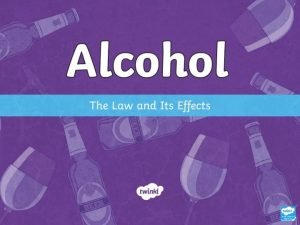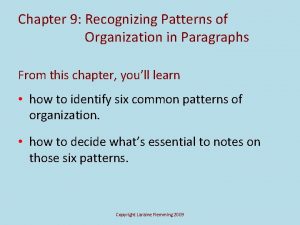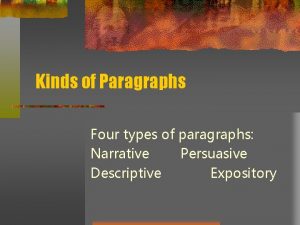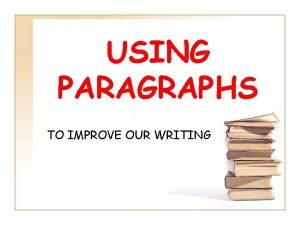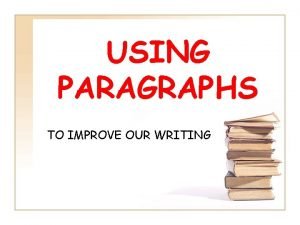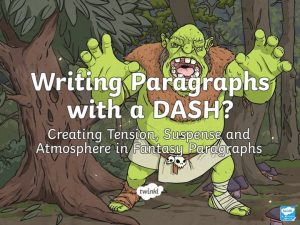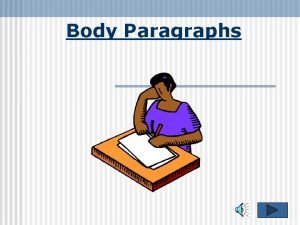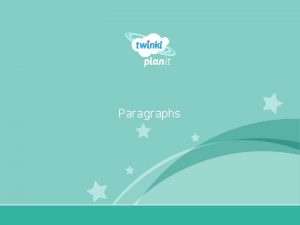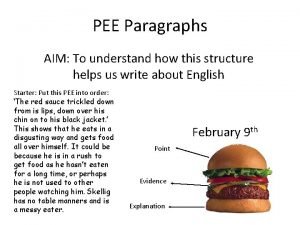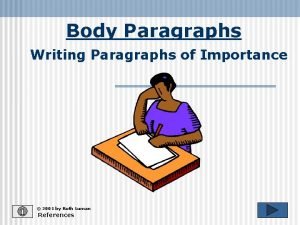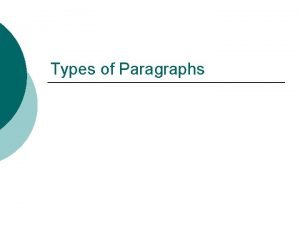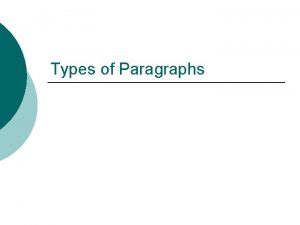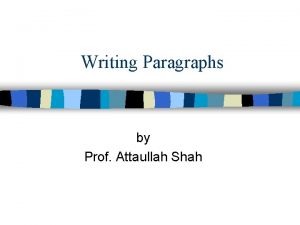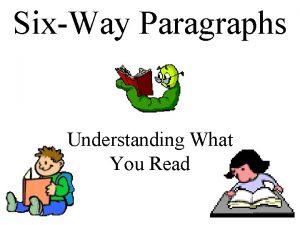Aim To understand how to use different paragraphs


















- Slides: 18


Aim • To understand how to use different paragraphs to describe a fantasy scene with suspense, tension and atmosphere. Success Criteria • IStatement can use ambitious 1 Lorem ipsum adjectives dolorinsitexpanded amet, consectetur noun phrases. adipiscing elit. • IStatement can punctuate 2 speech with inverted commas. • Sub statement • I can show a character is feeling through description of movements, feelings and body language. • I can use a cliff hanger or rhetorical question. • I can use the DASH? acronym to describe a scene.

How Can You Describe a Scene? Think about mystery stories you’ve really enjoyed reading. What makes the paragraphs within the description exciting and keeps you wanting to read more? How might an author achieve atmosphere, tension and suspense in their writing? We can use a series of paragraphs to describe a scene, with each paragraph having a special purpose.

What Are DASH? Descriptions? Using DASH? can help you to make your descriptions really exciting to hook your reader in and make them want to read on. DASH? helps you to describe a scene; adding tension, atmosphere and suspense to your writing. Each sentence in a DASH? description needs to follow this pattern… Description 1. Describe the setting using ambitious adjectives. Action 2. Make something exciting happen! Speech 3. Have your main character(s) speak to react to the action. How is your character feeling? ? 4. Show your character is feeling through their movements, reactions and body language. 5. Add a cliff hanger or rhetorical question.

Examining the Features of a DASH? Paragraph D Without warning, there was a sudden ear-piercing shriek right behind them. Courageously, Ben span round to investigate. A Menacing shadows loomed in the flickering streetlights as Ben and James anxiously tiptoed down Vanishing Lane. S “Who is it? Who’s there? ” mumbled Ben nervously as he tried to scramble for the reassurance of his friend’s arm, but James was gone. H Ben’s heart began to pound in his chest while his bewildered brain tried to process what had just happened. He gasped for air. ? Would he ever see his friend again?

Becoming an Author Imagine you are the author of a mystery story. Use this photograph as your inspiration. What could be happening in the story? What is it? Where is it? When is it happening? Who is there? Are your character(s) lost? Let’s work together to invent a DASH? paragraph…

Let’s DASH? Description Describe the setting using ambitious adjectives in expanded noun phrases. A simple noun phrase is a group of words, including a noun, which make up part of a sentence. Other words are added to give more information about the noun. An expanded noun phrase uses adjectives to add more detail about the noun the trees determiner the towering, shadowy trees determiner adjectives noun

Description Sentences On your whiteboards, use adjectives to describe the noun to turn these simple noun phrases into expanded noun phrases. simple noun phrase the trees the lodge the lane the sky expanded noun phrase the towering, shadowy trees Now, let's use some of these ideas to write some opening sentences to describe the scene in the picture. We need to set the scene of where our character(s) are and what they are doing.

Action Sentences Action Make something exciting happen! Talk with a partner about what might happen. Do the character(s)suddenly see or hear something? Does something happen to one of the characters? What do your characters do when the action happens? Now, let's use some of our ideas to write some action sentences.

Speech Sentences Speech Have your main character(s) speak to react to the action. Now we have our Action sentences, how will your character (s) react to this action? Work with a partner, imagine you are the character(s) in the story. Act out some direct speech. What will you say to yourself or what will you say to each other? Remember to think how your characters will be speaking (e. g. quiet, loud, scared, excited, nervous).

Punctuating Speech Now, we need to punctuate our speech, so we know who has said it and how they are saying it. Inverted commas ‘hug’ what is said. The reporting clause tells us how it is said and who said it. “We’re miles from home!” gasped Ahmed anxiously. Punctuation goes inside the closing inverted commas. Try to use an interesting word for ‘said’ that fits the situation. Remember to think how your characters will be speaking (e. g. quiet, loud, scared, excited, nervous).

Writing Speech Sentences On your whiteboard, write down your ideas for what our characters will say following the action sentence. Can you add inverted commas to ‘hug’ what is being said? Can you add a reporting clause to say who has spoken? Have you chosen an interesting word for ‘said’? What other punctuation do you need inside the closing inverted commas? Now, let’s add speech sentences to our DASH? paragraph.

How Sentences How is the character feeling? We can show our character is feeling through their movements, reactions and body language. What words or phrases could we use to describe how our character (s) might be feeling or moving? What facial expressions or body language might they be showing?

Freeze Frame It! In your pairs, create a freeze frame to show our character(s) in the story might be feeling. How would you be breathing? How would you be moving? How would your body react? Now, let’s use some of our ideas to write the next sentences for our shared DASH? description.

Adding a Cliff Hanger or Rhetorical Question Add a question to leave your reader guessing, to create suspense and excitement. You could add this to the end of your ‘How sentences’. A cliff hanger is a part of a story that is exciting or frightening, because you are left not knowing what will happen next. As he continued down the lane, he heard footsteps quickening behind him… A rhetorical question is one that doesn’t require an answer. It can be used to create suspense. Would he ever find his way home? Can you think of a rhetorical question that we can use to end our DASH? description?

Can You Work with a DASH? Now, it’s your chance to write your very own mystery DASH? description. Look at this photograph. Can you write a DASH? paragraph that is full of tension, suspense and atmosphere? D escription Action S peech H ow is your character feeling? ? Cliff hanger or rhetorical question

Reflection Can you remember what DASH? stands for? D escription A ction S peech H ow is your character feeling? ? Cliff hanger or rhetorical question Can you give an example of each? Have you included DASH? in your description of the scene?

 To understand recursion you must understand recursion
To understand recursion you must understand recursion Aim to understand
Aim to understand Simple listing pattern of organization
Simple listing pattern of organization Four kinds of paragraph
Four kinds of paragraph Make a paragraph
Make a paragraph Paragraph organization
Paragraph organization Thermosoftening plastics examples
Thermosoftening plastics examples Flame test principle
Flame test principle Sound will travel at different speeds in different mediums.
Sound will travel at different speeds in different mediums. Lrefraction
Lrefraction What is cultural relativism
What is cultural relativism Different angle different story
Different angle different story Different faces song
Different faces song Manufactured boards examples
Manufactured boards examples We are all different but the same
We are all different but the same Venn diagram different same different
Venn diagram different same different What is the logical view of data
What is the logical view of data How you use ict today and how you will use it tomorrow
How you use ict today and how you will use it tomorrow History helps us understand ourselves
History helps us understand ourselves

